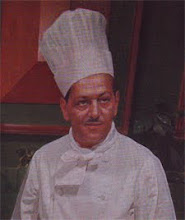Thickening has grown to mean the use of corn flour with many chefs and is only one of the many ways to thicken sauces. You have to think of the thickener as paint, the wrong colour for the room and the mood is spoiled. The various thickening agents correctly applied transforms food from ordinary to fantastic. How will you ever be able to experiment with sauces if you do not know the fundamentals. Remember with know artistry or discipline you are a cook not a chef.
So the traditional methods are; Roux
Beurre Manie
Arrowroot
Egg Yolk
Game Blood
Puree
Reduction
Roux
It is short sighted to see the roux as just equal portions of butter and flour. The butter must be melted slowly under a low heat stirring the flour in slowly off the heat to create a stable paste. Only then is the mixture returned to the flame to firm up the bond of the roux, usually just a minute.
The bond starts with the first signs of colour. A blond roux (the colour of pale straw) is preferable for lighter sauces and the brown roux (left on the heat longer) is preferable for brown sauces.
Any liquids should be added to the mixture should be heated up first and added warm or hot. Stirring until a smooth consistency is attained is paramount. Always allow the sauce to simmer over a low heat before serving.
A double boiler is essential for roux based sauces.
Beurre Manie
Thickening through kneaded butter is used on a sauce that is finished but not thick enough. Many wine sauces need to be thickened in this manner as cooking wine is seldom sold these days and chefs opt for what they are drinking that day. Mix 1 ½ tablespoons of butter with 2 tablespoons of flour to a smooth paste. Break it up into small pieces and bring the sauce to a rolling boil under a medium flame. Drop the pieces onto the top of the sauce slowly but evenly. Now lower the heat and gently shake the pan assisting the thickening process. This type of sauce does not keep and should served immediately. Do not re boil.
Arrowroot
Arrowroot has been around since the dawn of ages, what we get these days come from the West Indies colonies established by the British in the 18th century. The arrowroot plantations there have been passed through generations with quality and reputation being paramount. Corn flour is a similar starch based thickener and is considered to be of a lesser quality and not suitable for fine cuisine. Both acceptable solutions to last minute thickening. One teaspoon mixed to a paste and stirred back into the sauce will thicken a litre of sauce in seconds. This is by far the most practical and easiest way to thicken a sauce before serving.
Egg Yolk
Used by artists to make paint for centuries, egg yolk thickening is as old as sauce itself. It is the protein contained in the yolk which forms an emulsion with the liquid which , when gentle heat is applied, acts to thicken the sauce.
This can be a difficult sauce as if you heat the egg too much to fast it will curdle like scrambled eggs. Of course use a double boiler.
Always whisk the egg yolk with cold liquid before adding it to the sauce. The sauce should only be warm not hot. Stir sauce slowly on and off the flame. If the sauce is roux based additional heat may be used and the sauce may be simmered over a low flame without curdling.
Game Blood
This thickening method is only used with game recipes and like the egg yolk it is the protein which emulsifies and thickens the sauce. Low heat is the key here remembering the protein curdles at higher temperatures. Again mixing the agent with cool liquid first it is stirred into the sauce at a low temperature.
Fresh blood needs a splash of vinegar to prevent clotting if still warm, any other blood must be strained free from clots which will always form.
Puree
Most puree sauces have some stock already added. Mostly made up of cooked vegetables and are sieved or blended while hot and put back into the pot to cook further. Tomato sauce is a good example. Pumpkin soup is often boiled, blended and re heated.
Reduction
Nearly all sauces require reduction. It is the degree of reduction that is important. As with the tomato puree reduction to a paste is commonplace in cooking and is often preferable for delicate recipes. Reduction not only thickens the sauce but it improves flavours. Enhances them. Careful with salt and spice at this stage they do not reduce and should be added last. I always add salt at the plate never in the sauce. Many chefs would disagree with me on this point.


No comments:
Post a Comment